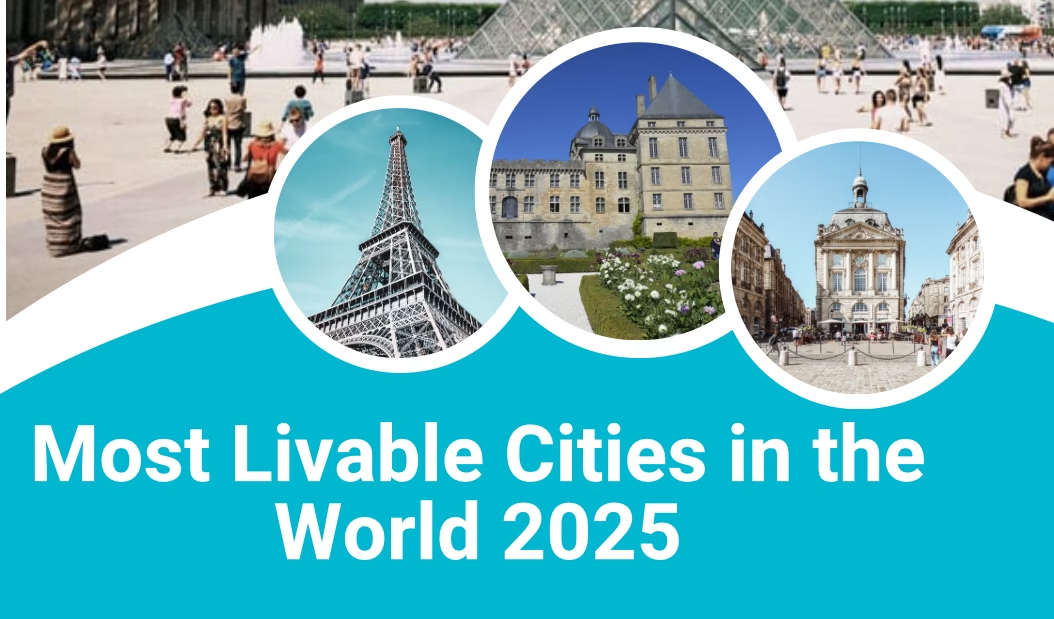The 10 Most Livable Cities in the World for 2025 based on the Economist Intelligence Unit’s (EIU) Global Liveability Index
Quality of life isn’t just about economic opportunity—it’s about stability, healthcare access, environmental quality, education, and infrastructure. The EIU’s 2025 Global Liveability Index assesses 173 cities on these five pillars. The average livability score stayed at 76.1 out of 100—but global stability took a hit due to geopolitical and social unrest.
This year’s ranking sees familiar European and Asia‑Pacific cities excel, while North America has just one representative in the top ten.
2025 Top 10 Most Livable Cities
| Rank | City, Country | Score | Highlights |
| 1 | Copenhagen, Denmark | 98.0 | Perfect scores in stability, education, infrastructure; top five in healthcare & culture |
| 2 | Vienna, Austria | 97.1 | Held top spot for 3 years; slight dip in stability due to terror incidents () |
| 2 | Zurich, Switzerland | 97.1 | Top-notch healthcare, education, and infrastructure () |
| 4 | Melbourne, Australia | 97.0 | Excellent across all pillars; vibrant urban culture () |
| 5 | Geneva, Switzerland | 96.8 | Consistently top-tier services; robust cultural environment () |
| 6 | Sydney, Australia | 96.6 | Strong healthcare, education, infrastructure () |
| 7 | Osaka, Japan | 96.0 | Boasts perfection in stability, education, and healthcare () |
| 7 | Auckland, NZ | 96.0 | Cultural richness and environmental quality shine () |
| 9 | Adelaide, Australia | 95.9 | Calm lifestyle, top marks in services () |
| 10 | Vancouver, Canada | 95.8 | Only North American city; excels in culture and healthcare () |
Deep Dive: Why These Cities Shine
1. Copenhagen
With an overall score of 98, Copenhagen achieved perfect 100s in stability, education, and infrastructure . Its cycling infrastructure, accessible housing, strong governance, and cultural vibrancy place it at the top.
2–3. Vienna & Zurich
Vienna drops slightly from its long-held dominance due to security concerns (e.g., attacks in 2024–25) but still scores 97.1, with flawless public services . Zurich matches Vienna’s score, leading Europe in healthcare and environment.
4–10. Asia-Pacific & Canada Expansion
Melbourne, Geneva, Sydney, Osaka, Auckland, Adelaide, and Vancouver round out the list—showcasing excellence in healthcare, education, and infrastructure. Vancouver stands out as North America’s lone top-ten city, balancing culture, services, and livability .
Regional Insights
North America: Although top-tier livability extends to many mid‑rank cities (e.g., Honolulu at #23), only Vancouver breaks into the elite list.
Western Europe continues to dominate with four top-3 cities and six in the top 10; however, stability scores dropped slightly due to political and terror unrest .
Asia-Pacific adds five strong performers, with Osaka tying at #7—the only Asian megacity in the top 10 .
What Makes a City Truly Livable?
Infrastructure (20%) – Efficient transport, housing, utilities, and connectivity
Stability (25%) – Low crime, political calm, and minimal threat from conflict.
Healthcare (20%) – High-quality public and private care, accessible to residents.
Culture & Environment (25%) – Green spaces, cultural life, low corruption.
Education (10%) – Strong schools and academic institutions.
EIU confirms that average scores in healthcare, education, and infrastructure are trending upward, even as stability slightly declines globally.
Conclusion
The 2025 ranking underscores several trends:
- Smaller and medium-sized cities outperform megacities, often due to their adaptable services and cohesive public systems.
- Europe and Asia-Pacific remain the gold standard for global livability.
- North America’s role in the global picture has diminished at the top tier—but still strong at the national/regional level.
Are you planning to relocate or simply dreaming of urban utopias? These cities offer strong examples of what makes a modern metropolis livable—safe, well-served, eco-friendly, and culturally rich.

